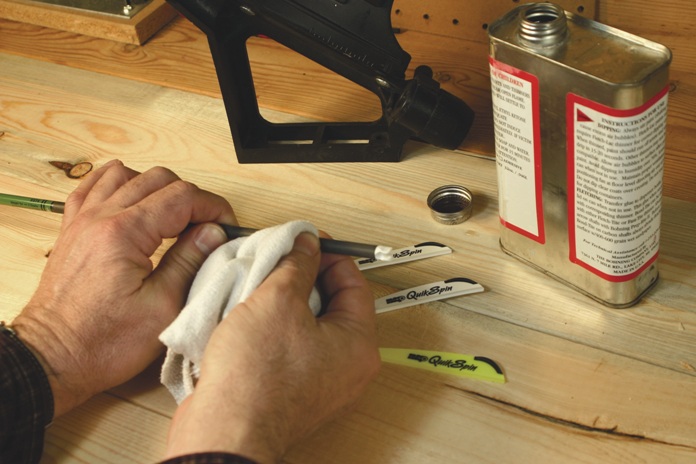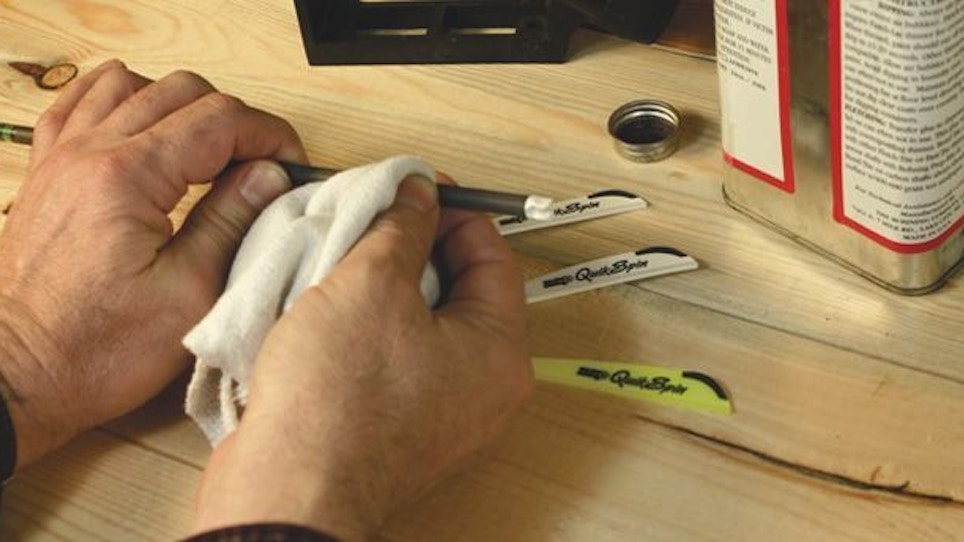Previously: Broadheads, Rest Styles, Fletching Contact
 Clean Right For Best Adhesion
Clean Right For Best Adhesion
There is no doubt that some adhesives work better for given combinations of fletching and shaft than do others. Still, assuming bowhunters read the labels enough to avoid buying adhesives made for wood or aluminum when they are shooting carbon, the most common source of adhesion problems is a failure to clean the shaft or the base of the vane adequately. Many solvents will do the trick, including isopropyl or denatured alchohol (not rubbing alcohol), acetone, lacquer thinner, or any of several products designed specifically for cleaning arrow shafts and vanes. The solvent should be applied with a clean cloth; keep in mind that fabric softeners and dryer sheets leave residues on cloth that get transferred to shafts or vanes and prevent adhesion. Similarly cotton swabs, such as Q-Tips, and most paper towels also contain materials that will contaminate the process. As soon as shafts and vanes are cleaned and dried, arrows can be fletched. Apply a thin strip of glue. Extra glue doesn’t mean extra holding power, and can mean less. For added durability, many bowhunters apply a drop of instant glue to the front and back of the vane.
Bowhunters who fletch with feathers have the option of using fletching tape. It’s less durable, but that is offset by the fact that arrows fletched using tape can be refletched very easily and quickly
Measure Your FOC
“FOC” is an acronym for “forward of center” and refers to the balance point of the arrow and the extent to which it is forward of the measured center of the arrow. Put simply, an arrow with a balance point that is at or behind the center is an unstable arrow—possibly dangerously so.
Lighter vanes can, to some extent, compensate for insufficient FOC. A few years ago an arrow with insufficient FOC was an uncommon phenomenon. It still is, but lighter shafts, and especially the trend toward lighter broadheads, has made it much easier for bowhunters to create arrows with insufficient FOC.
Optimum FOC for a broadhead-tipped arrow is generally around 10 percent, give or take a couple of percentage points, and somewhat less than that for target arrows. A balance point that is significantly farther forward than this will not destabilize the arrow, but will tend effect some loss of speed and a greater trajectory. To determine FOC, first measure the arrow from the tip of the broadhead to the throat of the nock and mark the center, then find the balance point and mark that. Measure the distance from the center to the balance point, then divide that number by the entire length. The result is the percentage of FOC.
Is it necessary to say that, for most setups, more than one kind of fletching will do the job? Beyond the given of adequate stabilization to achieve consistent accuracy, bowhunters have more options than ever for finding the fletching that will give them the qualities that work best with their setup and the qualities they most value in terms of arrow speed, durability, silence, or even appearance. Newer vanes offer some advantages, but the “if it ain’t broke, don’t fix it” rule always applies in bowhunting. If you are shooting tight, accurate groups with broadheads and are otherwise satisfied with your fletching, by all means, stay with the tried and true.






